|
 Secure Site
Secure Site
|
 |
Archive for the 'Yoga Timers by Now & Zen' Category
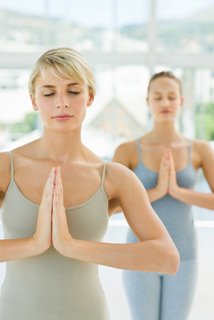 yoga Unless you’re a professional athlete, chances are you’re not getting a balanced workout during your workday. Whether you’re slaving away at a desk, making rounds, or waiting tables, you’re likely straining some muscles while ignoring others, leaving your body feeling stiff, sore, and physically exhausted. Deadlines and pressure from bosses don’t help matters, either.
“When you get stressed, you often hold your breath, which leads to holding your muscles. It feels like you’re wearing a straitjacket,” explains Elaine Petrone, a stress- and pain-management expert and creator of the “Stop the Back Pain” DVD.
You can stretch out the stress, though, with a little time and effort. “By pairing mindful stretches with deep breathing, you’ll make lasting, positive changes to the way your body works, looks, and feels,” says Petrone, who helped us develop this rejuvenating routine. Done for 15 to 20 minutes, three times a week, it paves the way to a calmer, less achy, and more energized you.
adapted from Body + Soul Magazine
Use our unique “Zen Clock” which functions as a Yoga Timer. It features a long-resonating acoustic chime that brings your meditation or yoga session to a gradual close, preserving the environment of stillness while also acting as an effective time signal. Our Yoga Timer & Clock can be programmed to chime at the end of the meditation or yoga session or periodically throughout the session as a kind of sonic yantra. The beauty and functionality of the Zen Clock/Timer makes it a meditation tool that can actually help you “make time” for meditation in your life. Bring yourself back to balance.
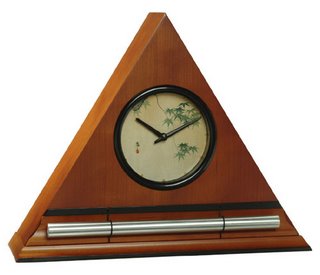 Zen Alarm Clocks and Yoga Timers with Gentle Chime Now & Zen – The Yoga Timer Store
1638 Pearl Street
Boulder, CO 80302
(800) 779-6383
Posted in Bamboo Chime Clocks, Well-being, yoga, Yoga Timer, Yoga Timers by Now & Zen, Zen Timers
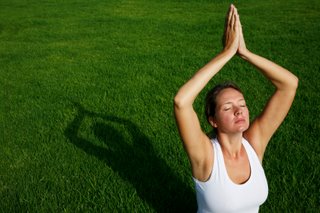 Outdoor Yoga That most familiar of asana sequences, Surya Namaskar (Sun Salutation) is as rich in symbolic and mythic overtones as it is in physical benefits.
In many cultures, light has long been a symbol of consciousness and self-illumination. “The world begins with the coming of light,” wrote Jungian analyst Erich Neumann in The Origins and History of Consciousness (Princeton University Press, 1995). “Opposition between light and darkness has informed the spiritual world of all peoples and molded it into shape.”
Our primary source of light is, of course, the sun. When we look at our closest star, we may see nothing more than a big yellow ball. But for thousands of years, the Hindus have revered the sun, which they call Surya, as both the physical and spiritual heart of our world and the creator of all life itself. That’s why one of Surya’s many other appellations is Savitri (the Vivifier), who, according to the Rig Veda, “begets and feeds mankind in various manners” (III.55.19). Moreover, since everything that exists originates from the sun, as Alain DaniŽlou wrote in The Myths and Gods of India (Inner Traditions, 1991), it “must contain the potentiality of all that is to be known.” For the Hindus, the sun is the “eye of the world” (loka chakshus), seeing and uniting all selves in itself, an image of and a pathway to the divine.
One of the means of honoring the sun is through the dynamic asana sequence Surya Namaskar (better known as Sun Salutation). The Sanskrit word namaskar stems from namas, which means “to bow to” or “to adore.” (The familiar phrase we use to close our yoga classes, namaste—te means “you”—also comes from this root.) Each Sun Salutation begins and ends with the joined-hands mudra (gesture) touched to the heart. This placement is no accident; only the heart can know the truth.
The ancient yogis taught that each of us replicates the world at large, embodying “rivers, seas, mountains, fields…stars and planets…the sun and moon” (Shiva Samhita, II.1-3). The outer sun, they asserted, is in reality a token of our own “inner sun,” which corresponds to our subtle, or spiritual, heart. Here is the seat of consciousness and higher wisdom (jnana) and, in some traditions, the domicile of the embodied self (jivatman).
It might seem strange to us that the yogis place the seat of wisdom in the heart, which we typically associate with our emotions, and not the brain. But in yoga, the brain is actually symbolized by the moon, which reflects the sun’s light but generates none of its own. This kind of knowledge is worthwhile for dealing with mundane affairs, and is even necessary to a certain extent for the lower stages of spiritual practice. But in the end, the brain is inherently limited in what it can know and is prone to what Patanjali calls misconception (viparyaya) or false knowledge of the self.
The eight basic postures, in order of performance, are Tadasana (Mountain Pose), Urdhva Hastasana (Upward Salute), Uttanasana (Standing Forward Bend), Lunge, Plank Pose, Chaturanga Dandasana (Four-Limbed Staff Pose), Urdhva Mukha Svanasana (Upward-Facing Dog Pose), and Adho Mukha Svanasana (Downward-Facing Dog Pose).
The transition from posture to posture is facilitated by either an inhalation or an exhalation. As you move through the sequence, watch your breath closely. Slow your pace or stop and rest entirely if your breathing becomes labored or shuts down altogether. Always breathe through your nose, not your mouth: Nasal breathing filters and warms incoming air and slows your breathing down, thereby lending the sequence a meditative quality and reducing the risk of hyperventilation.
To perform the sequence, start in Tadasana, with your hands together at your heart. Inhale and lift your arms overhead to Urdhva Hastasana, then exhale while lowering the arms down and fold your torso into Uttanasana. Then inhale, arch your torso into a slight backbend with the fingertips or palms pressed to the floor or blocks, and exhale while bringing your left foot back into a lunge. Inhale forward to Plank, then exhale and lower yourself into Chaturanga Dandasana. On an inhalation, arch your torso up as you straighten your arms into Upward Dog. Exhale back to Downward Dog; step the left foot forward on an inhalation into Lunge. Swing the right leg forward to Uttanasana on an exhalation, then lift your torso and reach your arms overhead on an inhalation to Urdhva Hastasana. Finally, lower your arms on an exhalation and return to your starting point, Tadasana.
Remember, this is only a half-round; you’ll need to repeat the sequence, switching left to right and right to left to complete a full round. If you’re just starting out, it might help to work on the poses individually before you put them together. (Visit www.YogaJournal.com for more how-to information.)
adapted from Yoga Journal, by Richard Rosen
Use our unique “Zen Clock” which functions as a Yoga Timer. It features a long-resonating acoustic chime that brings your meditation or yoga session to a gradual close, preserving the environment of stillness while also acting as an effective time signal. Our Yoga Timer & Clock can be programmed to chime at the end of the meditation or yoga session or periodically throughout the session as a kind of sonic yantra. The beauty and functionality of the Zen Clock/Timer makes it a meditation tool that can actually help you “make time” for meditation in your life. Bring yourself back to balance.
 Yoga timers from Boulder, Colorado Now & Zen – The Yoga Timer Store
1638 Pearl Street
Boulder, CO 80302
(800) 779-6383
Posted in intention, Now & Zen Alarm Clocks, wake up alarm clock, Well-being, yoga, Yoga Timer, Yoga Timers by Now & Zen
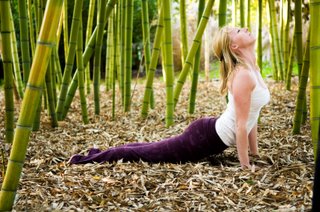 better posture from yoga Your mom was right: You’ll look better and feel great if you stop slouching and stand up straight. Yoga can help you do just that—in a way that honors your spine’s natural curves. Here’s a guide to assessing and improving your posture.
Are you a slumper? A swayer? Chances are you’re one or the other to some degree—despite Mom’s best efforts all those years ago to get you to sit up straight and stop slouching. She probably told you that you’d look and feel better if you worked on your posture, and she was absolutely right. But if you’re like most people, you rolled your eyes and ignored her, or straightened up until she wasn’t looking. And you probably didn’t give posture much more thought at all until you walked into your first yoga class and tried to stand in Tadasana (Mountain Pose).
When you’re a beginner, it’s surprisingly complicated to master the art of rooting down through the feet while lengthening up through the spine, keeping your chest open without jutting your lower ribs out, and keeping the legs muscles strong and lifted without tensing the belly or jaw. But ultimately, Tadasana demands just one simple thing: that you stand in a way that supports the natural curves of a healthy spine. So why is it so difficult? And why do we work so hard to master good posture in yoga—leaving class feeling taller and healthier—only to slump down in the car seat on the way home or revert to a swayback when we heft our overstuffed yoga bags onto our backs?
In short, modern life conspires against good posture. We spend our days sitting at desks, staring at computer screens. When we travel, we do it in cars or—worse—airplanes. We lounge around in overstuffed chairs designed more for looks than for lumbar support. And we pay people to mow our lawns, tend our gardens, and remove our trash so we can spend more time working or driving or sitting. Nonsedentary cultures—with a few exceptions—don’t have the same epidemic of back and neck problems that we do. Picture a woman gracefully balancing a large basket of food on her head. To carry such a heavy weight, she must have a perfectly aligned spine and strong posture-support muscles. You don’t get that kind of alignment and strength from sitting around and watching the tube. You can, however, get it from a regular yoga practice.
Take comfort in knowing that yoga trains your mind as well as your body. As you continue to devote yourself to your practice, you will become more present in your body and more aware of your alignment, and you will begin to naturally make choices that will improve your health and your quality of life. Over time, the combination of increased awareness and physical training will allow your improved alignment to spill out into other areas of your life. Before you know it, you’ll feel at ease as you practice good yoga alignment while you’re perched at your desk, standing at the copier, and sitting at dinner. You’ll be doing yoga during all of your waking hours. And who knows? You might just impress your mom!
adapted fromYoga Journal, by Julie Gudmestad
Use our unique “Zen Clock” which functions as a Yoga Timer. It features a long-resonating acoustic chime that brings your meditation or yoga session to a gradual close, preserving the environment of stillness while also acting as an effective time signal. Our Yoga Timer & Clock can be programmed to chime at the end of the meditation or yoga session or periodically throughout the session as a kind of sonic yantra. The beauty and functionality of the Zen Clock/Timer makes it a meditation tool that can actually help you “make time” for meditation in your life. Bring yourself back to balance.
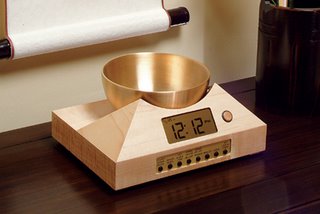 Zen Timepiece, a yoga timer and clock with Tibetan bowl Now & Zen – The Yoga & Meditation Timer Store
1638 Pearl Street
Boulder, CO 80302
(800) 779-6383
Posted in intention, Well-being, yoga, Yoga Timer, Yoga Timers by Now & Zen, Zen Timers
 Kids yoga There’s never a dull—or quiet—moment in Kate Roades’s yoga classes for kids. “Oh, it’s never silent,” she says, adding that chatting, laughter, and audible groans are the norm. Just recently a little student quipped midpose, “I am not a cobra, Teacher Kate, I am a seal.” Roades’s enthusiasm and accepting attitude during moments like these make her a great teacher—giggling is OK in her classes, as is saying a pose feels funny. She’s learned plenty of tricks teaching at It’s Yoga Kids, the San Francisco studio she opened with partner Michelle Wing in early 2006.
How can parents who want to practice with their kids follow her lead? First, says Roades, know that your child might not be hooked right away. Like adults, kids want to be good at things, and yoga can seem strange at first. “By the third time it’s usually not so foreign,” Roades says. She also encourages incorporating positions that your child already knows (like sitting cross-legged) into each session to build confidence. Once they are in a pose, tell them how many breaths they will stay in it, to help them feel safe. Finally, limit practices to 30 minutes or less and use language they’ll enjoy and understand.
Most of all, says Roades, make it fun, and your children will begin to feel stronger and calmer in their daily life. “Giving children the tools to feel confident is priceless,” Roades says. “Teaching kids how to relax and deal with their emotions is incredible.”
adapted from Yoga Jounal
Use our unique “Zen Clock” which functions as a Yoga Timer. It features a long-resonating acoustic chime that brings your meditation or yoga session to a gradual close, preserving the environment of stillness while also acting as an effective time signal. Our Yoga Timer & Clock can be programmed to chime at the end of the meditation or yoga session or periodically throughout the session as a kind of sonic yantra. The beauty and functionality of the Zen Clock/Timer makes it a meditation tool that can actually help you “make time” for meditation in your life. Bring yourself back to balance.
 Bamboo Yoga Timer for Kids Now & Zen – The Yoga Timer Store
1638 Pearl Street
Boulder, CO 80302
(800) 779-6383
Posted in intention, mindfulness practice, yoga, Yoga Timer, Yoga Timers by Now & Zen
 Savasana Pose - mindfulness practice Savasana, (corpse pose) is a relaxing posture that is intended to rejuvenate the body, mind and spirit. It is recommended that you set aside 20 minutes every day for Savasana , the most restful of the yoga positions. Here are some tips to get you started:
1. Set your meditation timer for 20 minutes so you don’t have to watch the clock. Use the Bamboo Zen Timer by Now & Zen with a calming chime. 2. Lie down on your back on a soft yet firm surface, such as a rug (but not a bed). Place a rolled pillow or blanket under your knees if that feels good, and cover your eyes with a soft cloth. Cover yourself with a light blanket.
3. Let your arms and legs roll slightly out from the body as you relax and begin to take a series of long, slow breaths, setting an intention to disengage from the external world. If your mind starts spinning away, simply return your attention to the breath.
4. When the meditation timer chimes, bend your knees, roll to the side, and sit up. After a moment or two of stillness, reengage with your day.
5. Repeat this every day. Savasana is a good way to reduce stress in your life and give you extra energy for the rest of your day.
 meditation timers with chime
Now & Zen
1638 Pearl Street
Boulder, CO 80302
(800) 779-6383
Posted in Meditation Timers, Meditation Tools, mindfulness practice, Well-being, yoga, Yoga Timer, Yoga Timers by Now & Zen, Zen Timers
 Yoga Corpse Pose Corpse Pose Meditation
This restful pose, called savasana in Sanskrit, provides a calming and centering ending to your yoga practice. This is when you allow all that you’ve just done to “soak in.” Set your Zen Meditation Timer to 15 minutes. Spend at least 10 to 15 minutes in corpse pose, lying on your back with your palms facing up. Use this meditation on the four elements to focus the mind and body.
Earth: Sense the earth supporting you and absorbing all unnecessary tension. Feel yourself being cradled by the ground beneath you, relaxed and breathing deeply.
Wind: Feel yourself being bathed by the wind, carrying your prayers and intentions on its wings while blowing away any nagging thoughts that come to mind.
Fire: Visualize a ring of fire surrounding you from a safe distance, protecting you from any threatening external forces and sealing in the energy from your practice. Picture yourself casting all unwanted tension and worry into the flames of that fire.
Water: Imagine a gentle rain cooling and purifying you, washing away all fears and anxiety, relaxing and refreshing you. Feel yourself floating in warm water, totally protected and balanced.
Four Elements: Visualize each of these four elements moving through you from the tips of your toes to your crown and back again. See this as a beautiful, spiritual, energizing flow of energy. Feel it balancing all of your internal systems and boosting your immune system in positive, healthy ways.
adapted from Wholeliving Magzine, July/August 2005 by Terri Trespicio
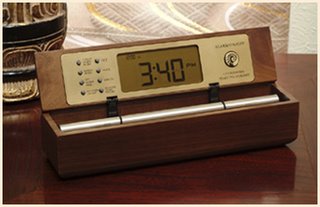 Digital Zen Alarm Clock, a meditation timer and progressive alarm clock
Now & Zen
1638 Pearl Street
Boulder, CO 80302
(800) 779-6383
Posted in yoga, Yoga Timer, Yoga Timers by Now & Zen
 yoga pose - water exercise Life-Giving, Calming
Water is vital, soothing and rejuvenating to our bodies and senses, and it’s the flow of water that inspires the easy, smooth flow of yoga practice. While doing yoga near a body of water can be very nourishing for the soul — its relaxing sounds, the cooling, calming energy it exudes — you don’t need to be near water to experience its effects. You can focus on the qualities of water and think of your own breath as flowing in and out of you like the tides, refreshing and nurturing every cell.
Water Exercise
This exercise is inspired by tai chi and includes both fluid movement and balance while standing in place.
1. Stand with heels together, toes apart.
2. Keeping your knees soft, rock back and forth to find perfect center balance.
3. With hands together in prayer position, reach up over your head through the air. Open your arms as if you’re doing a breaststroke, and push the air away as if it were water. Sweep your arms out and down, returning them to your sides. Inhale as you swim “out,” rise up on your toes, and exhale as you gently bring your hands back and lower onto your feet.
4. Repeat the motions at least 10 times, gradually working up to 20.
To Experience Water
Practice near a body of water — the ocean, a lake, or a swimming pool. Find a waterfall or fountain. Try practicing in the morning or evening to feel and see the dew on the grass and leaves. Practice meditation.
adapted from Wholeliving Nagazine, July/August 2005 by Terri Trespicio
 Digital Yoga and Meditation Chime Timer in Solid Walnut Now & Zen
1638 Pearl Street
Boulder, CO 80302
(800) 779-6383
Posted in yoga, Yoga Timer, Yoga Timers by Now & Zen
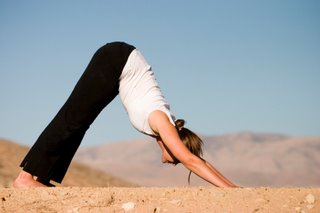 yoga downward facing dog pose Strength, Power
Fire is protective, purifying, and energizing. You can feel the power of fire from the sun, stars, and moon — whether you can see them or not. This kind of cosmic energy radiates through us on a sunny or overcast day, at dawn or dusk. Throughout your practice, as you draw energy from the earth and power from the wind, feel that influx of solar energy nurturing and purifying your mind, body, and soul. One way to nurture this energy is to feed your inner fire with a challenging, energy-building pose.
Fire Exercise
1. From Mountain pose move into Chair pose by first raising your arms so they are perpendicular to the floor and in line with the back and neck. Bend your knees and lower your tailbone as if you are sitting, lowering until your thighs are almost parallel to the ground. Keep your knees aligned with your ankles, and hold for five breaths.
2. Straighten legs and dive into a forward fold as you exhale, then step back into Downward-Facing Dog, hands and feet on the ground, hips raised, heels pressing toward the ground, arms firm, fingers spread, and palms flat. Hold for a few breaths to build heat in the body.
3. Exhale as you pull your left knee in toward your forehead and hold, engaging your core.
Return left leg to Downward Dog and repeat with the right leg. Jump or step your feet into forward fold; slowly roll up.
To Experience Fire
Feel the sun’s warmth on your body. Bathe in cool moonlight and starlight, which are reflected from the sun. Watch for fireflies after sundown. Practice by candlelight.
adapted from WholeLiving Magazine, July/August 2005 by Terri Trespicio
 Digital Zen Alarm Clocks and Timers for Yoga and Meditation with Chimes
Now & Zen
1638 Pearl Street
Boulder, CO 80302
(800) 779-6383
Posted in yoga, Yoga Timer, Yoga Timers by Now & Zen
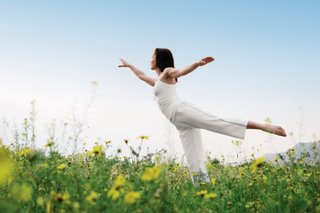 Yoga Wind Exercise Freedom, Breath
The wind is a nurturing influence — it gives us our breath, and, according to ancient Tibetan lore, carries our prayers around the world on “wind horses” to where they’re needed. Wind is also a great connecting force. It cannot be contained; it’s the definition of freedom. Wind can introduce the element of surprise in your outdoor practice — like a dance partner, you need to respond to it.
This exercise, paired with gentle breathing, releases tension in the muscles while helping you perfect your balance and strengthen your spine. Imagine yourself caressed, lightened, and strengthened by the wind.
Wind Exercise
1. Stand in Mountain pose with a slightly widened stance and feet firmly on the ground.
2. Begin a spinal rotation, starting at the waist and gently turning the upper body, face, shoulders, arms, and hands from side to side. Rotate the spine like a washing machine, allowing the muscles to release and the arms to flop loosely, patting the body with each turn. Let the movement flow back and forth.
3. Breathe in for one complete rotation, then out for a rotation; keep this rhythm going for at least 20 rotations.
4. Return to center. Bring your heels together with toes slightly apart, and let your arms relax at your sides.
To Experience the Wind
Choose a spot on higher ground or in a clearing. Become aware of the air around you, its subtle movement over your skin. Feel the air with all of your senses — smell it, taste it, touch it, and hear it.
Imagine you are the wind and can move effortlessly.
adapted from Wholeliving Magazine, July/August 2005
 bamboo meditation timer and natural alarm clock
Now & Zen
1638 Pearl Street
Boulder, CO 80302
(800) 779-6383
Posted in yoga, Yoga Timer, Yoga Timers by Now & Zen
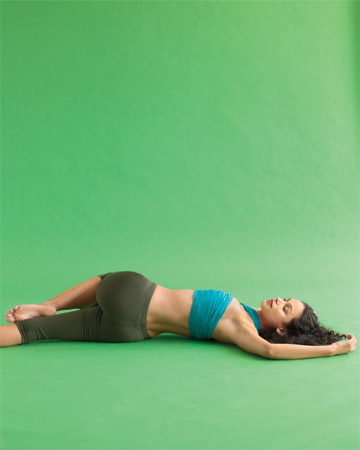 yoga, loosen up pose Saturday: Loosen Up
The sun’s out and the day’s wide open. Savor your Saturday by twisting away any residual tension in your back. It’s a delicious way to wake up — or even wind down after running around town.
Supported Reclined Twist
What It Does
Helps the whole body (hips, spine, digestive system, nervous system, shoulders, chest, etc.) unwind. Promotes digestion and detoxification.
How to Do It
Set your Zen Yoga Timer to gong after 5 minutes. Lie on your back, dropping your left knee across your body to rest on a pillow or blanket. Shift your hips right to avoid over-twisting the lower back.
Rest your arms, elbows soft, on the floor over your head. Turn your head in whichever direction feels most comfortable and breathe into this gentle stretch for 5 minutes on each side, until the gong chimes.
adapted from Body + Soul, 2010
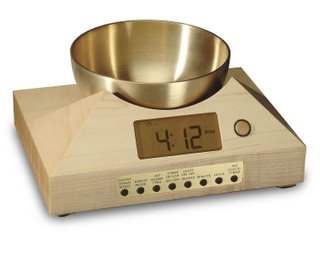 Zen Yoga Timepiece in Maple Now & Zen
1638 Pearl Street
Boulder, CO 80302
(800) 779-6383
Posted in Chime Alarm Clocks, Japanese Inspired Zen Clocks, Well-being, Yoga Timer, Yoga Timers by Now & Zen, Zen Timepiece by Now & Zen, Zen Timers
« Previous Page — « Previous Entries
Next Entries » — Next Page »
|
|
|
|